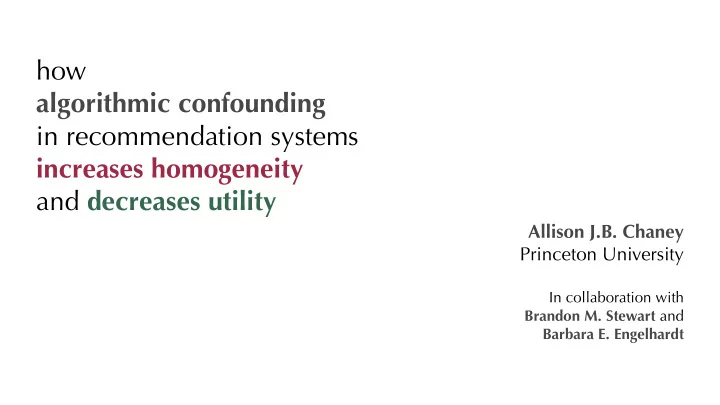

how algorithmic confounding in recommendation systems increases homogeneity and decreases utility Allison J.B. Chaney Princeton University In collaboration with Brandon M. Stewart and Barbara E. Engelhardt
Simulation Setup
Simulation Setup alternative realities “world” content filtering social filtering matrix factorization popularity random ideal
Jaccard Index ) = ) = | A ∩ B |
Jaccard Index ) = ) = | A ∩ B | J ( A, B ) = | A ∩ B | ) = | A ∪ B |
100 0 iteration
100 0 iteration
100 0 iteration
Claim 1: The recommendation feedback loop causes homogenization of user behavior .
change in Jaccard index content MF popularity random social 0.50 0.25 0.00 − 0.25 − 0.6 − 0.4 − 0.2 0.0 − 0.6 − 0.4 − 0.2 0.0 − 0.6 − 0.4 − 0.2 0.0 − 0.6 − 0.4 − 0.2 0.0 − 0.6 − 0.4 − 0.2 0.0 utility relative to ideal
change in Jaccard index content MF popularity random social 0.50 0.25 0.00 − 0.25 − 0.6 − 0.4 − 0.2 0.0 − 0.6 − 0.4 − 0.2 0.0 − 0.6 − 0.4 − 0.2 0.0 − 0.6 − 0.4 − 0.2 0.0 − 0.6 − 0.4 − 0.2 0.0 utility relative to ideal
change in Jaccard index content MF popularity random social 0.50 0.25 0.00 − 0.25 − 0.6 − 0.4 − 0.2 0.0 − 0.6 − 0.4 − 0.2 0.0 − 0.6 − 0.4 − 0.2 0.0 − 0.6 − 0.4 − 0.2 0.0 − 0.6 − 0.4 − 0.2 0.0 utility relative to ideal
change in Jaccard index content MF popularity random social 0.50 0.25 0.00 − 0.25 − 0.6 − 0.4 − 0.2 0.0 − 0.6 − 0.4 − 0.2 0.0 − 0.6 − 0.4 − 0.2 0.0 − 0.6 − 0.4 − 0.2 0.0 − 0.6 − 0.4 − 0.2 0.0 utility relative to ideal
Claim 2: Users experience losses in utility due to homogenization effects; these losses are distributed unequally .
Gini Coefficient A G ( A, B ) = line of equality A + B popularity of items item popularity curve (usually long tail) A ) = B items ordered by popularity
Gini Coefficient A G ( A, B ) = line of equality A + B popularity of items item popularity curve (usually long tail) A G ∈ [0 , 1] ) = B maximal maximal equality items ordered by popularity inequality
Claim 3: The feedback loop amplifies the impact of recommendation systems on the distribution of item consumption .
Why do we need to think about algorithmic confounding ?
Why do we need to think about algorithmic confounding ? better evaluation of recommendation systems
Why do we need to think about algorithmic confounding ? better evaluation of recommendation systems understand the impacts on human behavior
Why do we need to think about algorithmic confounding ? better evaluation of recommendation systems understand the impacts on human behavior design better systems to increase fairness and social welfare
Recommend
More recommend